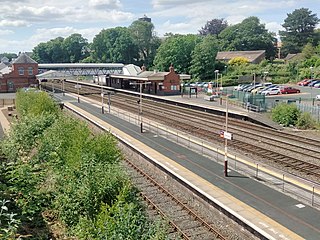
Audlem is a village and civil parish located in Cheshire, North West England. In 2021, it had a population of 1,832.

Market Drayton is a market town and civil parish on the banks of the River Tern in Shropshire, England. It is close to the Cheshire and Staffordshire borders. It is located between the towns of Whitchurch, Wem, Nantwich, Newcastle-under-Lyme, Newport and the city of Stoke on Trent. The town is on the Shropshire Union Canal and bypassed by the A53 road.

The Shropshire Union Canal, sometimes nicknamed the "Shroppie", is a navigable canal in England. The Llangollen and Montgomery canals are the modern names of branches of the Shropshire Union (SU) system and lie partially in Wales.

Woore is a village and civil parish in the north east of Shropshire, England. The population of the village as recorded in the 2011 census is 633, and for the civil parish is 1,069. The civil parish extends to about 3,950 acres.

Hodnet is a village and civil parish in Shropshire, England. The town of Market Drayton lies 5.7 miles (9.2 km) north-east of the village. In 2011 the parish had a population of 1534.

The English county of Shropshire has a fairly large railway network, with 19 National Rail stations on various national lines; there are also a small number of heritage and freight lines, including the famous heritage Severn Valley Railway running along its eastern border with Worcestershire.

The Wolverhampton–Shrewsbury line is the railway line from Wolverhampton to Shrewsbury via Wellington; it was originally built by the Shrewsbury and Birmingham Railway. The line is double track throughout, with rarely used relief sidings at Cosford and four tracks through Wellington station.

The Shropshire Union Railways and Canal Company was a Company in England, formed in 1846, which managed several canals and railways. It intended to convert a number of canals to railways, but was leased by the London and North Western Railway (LNWR) from 1847, and although they built one railway in their own right, the LNWR were keen that they did not build any more. They continued to act as a semi-autonomous body, managing the canals under their control, and were critical of the LNWR for not using the powers which the Shropshire Union Company had obtained to achieve domination of the markets in Shropshire and Cheshire by building more railways.

The Shrewsbury and Birmingham Railway was authorised in 1846. It agreed to joint construction with others of the costly Wolverhampton to Birmingham section, the so-called Stour Valley Line. This work was dominated by the hostile London and North Western Railway, which used underhand and coercive tactics. The section between Shrewsbury and Wellington was also built jointly, in this case with the Shropshire Union Railway.

Wellington railway station serves the town of Wellington, Shropshire, England. It is situated on the former Great Western Railway's London Paddington to Birkenhead via Birmingham Snow Hill line. Trains are operated by West Midlands Railway, and Transport for Wales.

Nantwich railway station serves the town of Nantwich, Cheshire, England. It is on the Crewe to Shrewsbury line 4+1⁄2 miles (7.2 km) south west of Crewe. Opened in 1858, it was the junction for the Great Western Railway route to Wellington via Market Drayton until 1963.
The Wellington to Craven Arms Railway was formed by a group of railway companies that eventually joined the Great Western Railway family, and connected Wellington, Shropshire and Shifnal, with Coalbrookdale, Buildwas, Much Wenlock and a junction near Craven Arms. Its objectives were dominated by the iron, colliery and limestone industries around Coalbrookdale.
The Stoke to Market Drayton Line was a railway line that ran through Staffordshire and Shropshire that was built by the North Staffordshire Railway.

The Nantwich and Market Drayton Railway was a standard gauge railway line which began as a single line branch in the early 1860s and rapidly became part of the Great Western Railway's (GWR) double track Wellington to Nantwich Railway, which had through trains to Crewe. It carried through freight and local passenger traffic until its closure in the 1960s. Market Drayton was renowned for the manufacture of gingerbread, hence the line acquired the nickname the "Gingerbread Line".

The Wellington and Drayton Railway was a standard gauge line in Central England which carried through freight and local passenger traffic until closure in the 1960s. It was part of the Great Western Railway's double track Wellington-Crewe line, linking the Midlands to the north and northwest.

The Coalport branch line was a standard gauge London and North Western Railway branch line in Shropshire, England, which ran between Hadley Junction near Oakengates on the Stafford to Shrewsbury line and a terminus at Coalport East railway station on the north bank of the River Severn at Coalport.

Pipe Gate was a railway station on the North Staffordshire Railway's Stoke to Market Drayton Line.

Wollerton is a small village within the civil parish of Hodnet in Shropshire, England. It lies approximately three miles to the south west of Market Drayton and sits on the old A53 and adjacent to the new Hodnet bypass which forms the new route of the A53.

Market Drayton railway station served the town of Market Drayton in Shropshire, England, between 1863 and 1963. It was at the junction where three railway lines met: two of them, forming the Great Western Railway route between Wellington and Crewe, were met by a line from Stoke-on-Trent on the North Staffordshire Railway.















